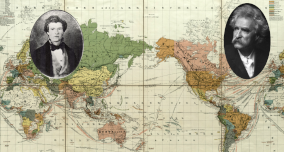The Blue Mountains is a mountainous region in New South Wales, Australia. It borders on Sydney's metropolitan area, its foothills starting about 50 kilometres (31 mi) west of the state capital.[2] The public's understanding of the extent of the Blue Mountains is varied, as it forms only part of an extensive mountainous area associated with the Great Dividing Range. Officially the Blue Mountains is bounded by the Nepean and Hawkesbury Rivers in the east, the Coxs River and Lake Burragorang to the west and south, and the Wolgan and Colo Rivers to the north.[3] Geologically, it is situated in the central parts of the Sydney Basin.[4]
The Blue Mountains are a dissected plateau carved in sandstone bedrock. They are now a series of ridge lines separated by gorges up to 760 metres (2,490 ft) deep. The highest point in the Blue Mountains, as it is now defined, is an unnamed point with an elevation of 1,189 m (3,901 ft) seven kilometres north-east of Lithgow. However, the highest point in the broader region once considered to be the Blue Mountains is Mount Bindo, elevation 1,362 m (4,469 ft).[5] A large part of the Blue Mountains is incorporated into the Greater Blue Mountains Area World Heritage Site, consisting of seven national park areas and a conservation reserve.[6]
The Blue Mountains area includes the local government areas of the City of Blue Mountains, the City of Hawkesbury, the City of Lithgow and Oberon Shire.
https://en.wikipedia.org/wiki/Blue_Mountains_(New_South_Wales)
"We changed cars. This was at Albury. And it was there, I think, that the growing day and the early sun exposed the distant range called the Blue Mountains. Accurately named. "My word!" as the Australians say, but it was a stunning color, that blue. Deep, strong, rich, exquisite; towering and majestic masses of blue—a softly luminous blue, a smouldering blue, as if vaguely lit by fires within. It extinguished the blue of the sky—made it pallid and unwholesome, whitey and washed-out. A wonderful color—just divine.
A resident told me that those were not mountains; he said they were rabbit-piles. And explained that long exposure and the over-ripe condition of the rabbits was what made them look so blue. This man may have been right, but much reading of books of travel has made me distrustful of gratis information furnished by unofficial residents of a country. The facts which such people give to travelers are usually erroneous, and often intemperately so. The rabbit-plague has indeed been very bad in Australia, and it could account for one mountain, but not for a mountain range, it seems to me. It is too large an order." (FTE p153-154)
It is more likely that he saw them in the setting sun the evening before. (Shillingsburg p58).
